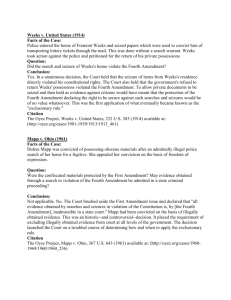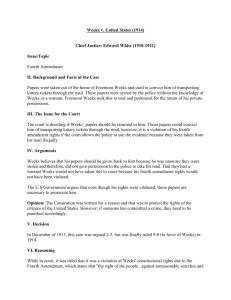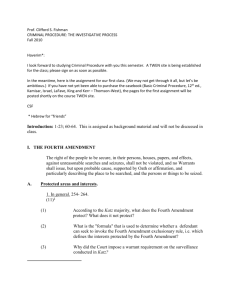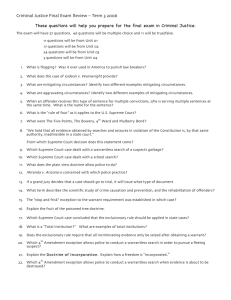Search and Seizure - College of Education
advertisement
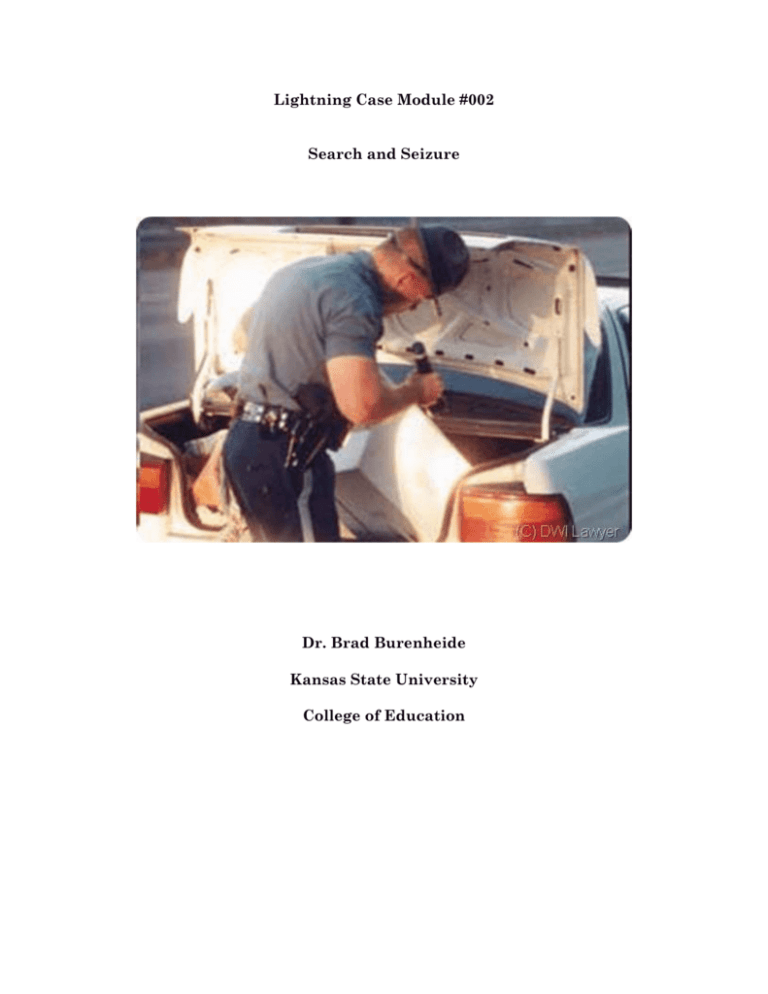
Lightning Case Module #002 Search and Seizure Dr. Brad Burenheide Kansas State University College of Education Contents For Teachers: Overview of Lightning Case Module 3 Introduction to the Controversy 7 The Cases 8 Weeks v. US (1914) Mapp v. Ohio (1961) Katz v . U.S. (1967) Illinois v. Gates (1983) Nix v. Williams (1984) Flippo v. West Virginia (1999) Brigham City, UT v. Stuart (2006) For Teachers: More About the Cases (decisions and more) 12 Final Assessment California v. Greenwood (1987) 14 Bibliography 15 For Teachers: Overview of Lightning Case Model Under the ruling levied in Marbury v. Madison, the Supreme Court became the institution in the American legal system that serves as the ultimate arbiter of issues of constitutional law. In the opinion, Justice John Marshal noted that “the judicial power of the United states is extended to all cases arising under the Constitution…It is also not entirely unworthy of observation that, in declaring what shall be the supreme law of the land, the Constitution, itself is first mentioned, and not the laws of the United States generally, but those only which shall be made in pursuance of the Constitution, have the rank (Marbury v. Madison, 1803).” Under this system of judicial review, it becomes extremely important for students to understand the rights contained with the Constitution and the subsequent Bill of Rights as the Constitution is the ultimate law of the United States. As precedents developed, the scope of the rights of citizens has evolved over time. Thus, it becomes important for citizens to follow this evolution and how the courts currently measure these rights. As Vontz and Leming noted, the use of Supreme Court cases lend themselves well to certain methods (Vontz & Leming, 2003). But, in this specific case, it is important to realize that the method must be integrated with the content. Vontz and Lemming further suggest civics educators who utilize active and participatory strategies, analyze documents and issues, teach with relevant topics, and teach civics content relevant to democratic citizenship can best motivate students to acquire knowledge of citizenship. One of the means of doing this is through the analysis of Supreme Court cases. The case study method of court decisions can engage students in gaining key knowledge through the analysis of important cases (McDonnell, 2002; Long, 1994). Vontz and Leming denote however that the understanding of the “bigger topics” of citizenship can be collected from the study of Supreme Court cases than the law students analyzing cases for method and specific topics of study (Vontz & Leming, 2003). These cases can allow students to investigate facts, issues, arguments, context, civic principles, and higher order thinking skills (Knapp, 1993; Leming, 1991). While there are common strategies to dissect cases of the Supreme Court, many of them can be heavily involved and use up a large amount of time in the classroom. Hanna and Dettmer (2004) encourage the teacher when designing assessments to maintain a balance between reliability, authenticity, and economy. Reliability would be accuracy of the measurement. Authenticity deals with the real-world application of knowledge to encourage transfer of learning. Economy deals with the use of time, effort, and energy in administering the assessment. Where economy focuses on the great “enemy” of the teacher—time—the teacher must consider if the strategy is the optimal and most appropriate use of time. In their article encouraging the use of Supreme Court cases, Vontz and Leming (2003) called for the use of Socratic seminars and moot court cases to effectively analyze the thinking of the court, the institution of the case in an historical context, and by taking an active role in the participating of the activity, becoming content experts of the case. But is this the best use of time in the classroom? Does the depth of content in this instance supersede the coverage of breadth? This study intends to analyze this question by employing a strategy that employs a significant quantity of cases without sacrificing the apparent quality of learning. Description of the Model The “Lightning Case” method discussed in this study is rooted in a sound literature base of experiential learning. Kolb (1984) and Kolb and Lewis (1986) provide a model for experiential learning or having students actively engaged in testing explanatory ideas created by the student. Mukhamedyarova (2005) explored the idea of interactive learning and evaluated five strategies commonly used. O’Brien (2003) discussed a model for students to engage in historical prediction making. Finally, Hess (2002) and Parker (2003) illuminated the nature of controversial deliberation in the classroom and provided guidelines for teachers to follow. Through the sources cited above, a model was constructed that causes students to be actively engaged in the analysis of cases, make predictions based upon their knowledge of the Constitution, and discuss with fellow students, albeit briefly, about their decisions and rationale. Figure 1 provides a visual overview of the model. Figure 1: An Overview of the “Lightning Case” Model Teacher Guides Overview of Right/Concept in Question Students deliberate a number of illustrative cases dealing with the concept. Students tackle a Students conceptualize number of the boundscases of the illustrative right/concept in the eyes dealing with the of the law. concept. The model provides students with the opportunity to utilize several cases to develop their own conceptualization of the boundaries of liberty within society and in the “eyes of the law.” The teacher provides a brief overview of the rights enumerated in the Constitution based upon the specific concept that will be addressed. After this introduction, several cases are presented to the student in a written or oral format with a short synopsis of the key facts of illustrative Supreme Court cases. Pending on the teacher’s preference, students may be given the opportunity to deliberate with their classmates, or they will create their own decision of the case. After the court’s actual decisions are shared with the students with brief rationale for their decision, students conceptualize the boundary of the right or concept discussed in the “Lightning Case” session. Introduction to the Controversy The Fourth Amendment The right of the people to be secure in their persons, houses, papers, and effects, against unreasonable searches and seizures, shall not be violated, and no Warrants shall issue, but upon probable cause, supported by Oath or affirmation, and particularly describing the place to be searched, and the persons or things to be seized. In this module, you will explore a set of cases that have set the precedents dealing with search and seizure. You will read a short synopsis of the case and based on the facts given, provide their opinion of the case. The teacher will then inform you if it was correct or not. Continue looking at the cases and see if you can determine what the bounds of the case are. The Cases Weeks v. U.S. (1914) Overview of the Case Police entered the home of Fremont Weeks and seized papers, which were used to convict him of transporting lottery tickets through the mail. This was done without a search warrant. Weeks took action against the police and petitioned for the return of his private possessions. Question Did this search and seizure violate Week’s Fourth Amendment Rights? Mapp v. Ohio (1961) Overview of the Case Dolree Mapp was convicted of possessing obscene materials after an admittedly illegal police search of her home for a fugitive. She appealed her conviction on the basis of freedom of expression. Question Is the evidence obtained illegally admissible in a court of law? Katz v. U.S. (1967) Overview of the Case Acting on a suspicion that Katz was transmitting gambling information over the phone to clients in other states, Federal agents attached an eavesdropping device to the outside of a public phone booth used by Katz. Based on recordings of his end of the conversations, Katz was convicted under an eight-count indictment for the illegal transmission of wagering information from Los Angeles to Boston and Miami. On appeal, Katz challenged his conviction arguing that the recordings could not be used as evidence against him. The Court of Appeals rejected this point, noting the absence of a physical intrusion into the phone booth itself. The Court granted certiorari and heard the case. Question Does the Fourth Amendment protection against unreasonable searches and seizures require the police to obtain a search warrant in order to wiretap a public pay phone? Illinois v. Gates (1983) Overview of the Case The Bloomingdale, Illinois Police Department received an anonymous tip that Lance and Susan Gates were selling drugs out of their home. After observing the Gates's drug smuggling operation in action, police obtained a warrant and upon searching the suspects' car and home uncovered large quantities of marijuana, other contraband, and weapons. Question Did the search of the Gates's home violate the Fourth and Fourteenth Amendments? Nix v. Williams (1984) Overview of the Case Williams was arrested for the murder of a ten-year-old girl. He disposed of the body along a gravel road. State law enforcement officials engaged in a massive search for the child's body. During the search, after responding to an officer's appeal for assistance, Williams made statements to the police (without an attorney present) which helped lead the searchers to the child's body. The defendant's Miranda rights were only read to him after his arrest. Question Should evidence resulting in an arrest be excluded from trial because it was improperly obtained? Note bene It would be extremely difficult to convict Williams of murder without the discovery of the body. Thus, the evidence of the body would be vital for the prosecution’s case. Flippo v. West Virginia (1999) Overview of the Case In 1996, James Michael Flippo called 911 to report that he and his wife had been attacked while camping in a West Virginia state park. Inside Flippo's cabin, officer's found his wife, with fatal head wounds. During their search, officers found and opened a closed briefcase, in which they discovered various photographs and negatives that allegedly incriminated Flippo. After he was indicted for murder, Flippo moved to suppress the photographs and negatives on the grounds that the police had obtained no warrant, and that no exception to the warrant requirement of the Fourth Amendment had justified the search and seizure. The Circuit Court denied the motion to suppress on the ground that the officers, having secured the homicide crime scene for investigative purposes, had been within the law to conduct a thorough investigation and examination of anything and everything found within the crime scene area. On appeal, the Supreme Court of Appeals of West Virginia denied discretionary review. Flippo took the case to the Supreme Court that heard the case. Question Does the judgment of a West Virginia Circuit Court, which denied a motion to suppress evidence on the ground that the police were entitled to make a thorough search of any crime scene and the objects found there violate Flippo’s Fourth Amendment rights? Brigham City, UT v. Stuart (2006) Overview of the Case Responding to a complaint about a loud party, police arrived at a house where they saw minors drinking alcohol outside and heard shouting inside. As they approached the house, they saw a fight through the window involving a juvenile and four adults, one of whom was punched hard enough to make him spit blood. The officers announced their presence, but the people fighting did not hear them so they entered the home. They arrested the men for contributing to the delinquency of a minor and other related offenses. The trial court judge, however, refused to allow the evidence collected after the police entered the home because it was a warrantless search in violation of the Fourth Amendment. On appeal, the government argued that the search was covered by the "emergency aid doctrine" because the officers were responding to seeing the man be punched. The Supreme Court of Utah disagreed, however, ruling that the doctrine only applies when there is an unconscious, semiconscious, or missing person who is feared injured or dead. The Court also gave weight to the fact that the officers acted exclusively in a law enforcement capacity, not to assist the injured man. Question Were the events of the case significant enough to trigger the emergency aid exception to the Fourth Amendment's warrant requirement? For Teachers: More About the Cases Weeks v. US (1914) In a unanimous decision, the court declared that the search was unconstitutional. This case established the “exclusion rule” for case law. This rule established that evidence obtained illegally could not be used in a court of law. Mapp v. Ohio (1961) In a 6-3 ruling, the Court ruled the search was unconstitutional. The case was significant as it applied the exclusion rule to both the federal government (Weeks) and to state governments. Katz v. U.S. (1967) In a 7-1 decision, the Court ruled that the wiretap was unconstitutional. The justices ruled that the 4th Amendment “protects people” not just evidence. Illinois v. Gates (1983) In a 6-3 decision, the court found no violation of the police department’s actions. They stated that the police acted within a “totality of circumstances.” Nix v. Williams (1984) In a 7-2 decision, the Court developed the “inevitable discovery” doctrine. As it was determined that the volunteer’s would have eventually found the body, it could be admitted as evidence. Flippo v. West Virginia (1999) In a 9-0 decision, the Court said that in investigating a murder scene, those conducting the search do not receive free reign to search parts of the scene if there is no likelihood of finding other suspects or victims. Thus, the search of the police was unconstitutional. Brigham City, UT v. Stuart (2006) In a unanimous decision, the Supreme Court ruled that police may enter a building without a warrant when they have an objectively reasonable basis to believe that an occupant is “seriously injured or threatened with such injury.” Chief Justice John Roberts wrote “[t]he need to protect or preserve life or avoid serious injury is justification for what would be otherwise illegal absent an exigency or emergency.” The actions of the Brigham City police department were legal. Final Assessment California v. Greenwood (1987) The court decided 6-2 that garbage placed at the curbside is unprotected by the Fourth Amendment. The Court argued that there was no reasonable expectation of privacy for trash on public streets “readily accessible to animals, children, scavengers, snoops, and other members of the public.” The Court also noted that the police cannot be expected to ignore criminal activity that can be observed by “any member of the public.” Final Assessment: Review your understanding of the Fourth Amendment from the cases you have explored to this point in time. You will be given a final case to decide upon. In addition to your decision, you need to write a position as to why you decided how you did. A note of warning, this case is a tough one to decide. To support your decision, it would be important for you to cite previous cases in your decision. California v. Greenwood (1987) Overview of the Case Local police suspected Billy Greenwood was dealing drugs from his residence from an anonymous tip. Because the police did not have enough evidence for a warrant to search his home, they searched the garbage bags Greenwood had left at the curb for pickup. The police uncovered evidence of drug use, which was then used to obtain a warrant to search the house. That search turned up illegal substances, and Greenwood was arrested on felony possession charges. Question Did the warrantless search and seizure of Greenwood's garbage violate the Fourth Amendment's search and seizure guarantee? Bibliography Cover Graphic: http://www.dwiblog.org/wp-content/uploads/2009/07/officer_search.jpg Overview of the Controversy http://wikipedia.org/wiki/Fourth_Amendment_to_the_United_States_Constitution Weeks v. US (1914) http://www.oyez.org/cases/1901-1939/1913/1913_461 Mapp v. Ohio (1961) http://www.oyez.org/cases/1960-1969/1960/1960_236 Katz v. U.S. (1967) http://www.oyez.org/cases/1960-1969/1967/1967_35 Illinois v. Gates (1983) http://www.oyez.org/cases/1980-1989/1982/1982_81_430 Nix v. Williams (1984) http://www.oyez.org/cases/1980-1989/1983/1983_82_1651 Flippo v. West Virginia (1999) http://www.oyez.org/cases/1990-1999/1999/1999_98_8770 Brigham City, UT v. Stuart (2006) http://www.oyez.org/cases/2000-2009/2005/2005_05_502 California v. Greenwood (1987) http://www.oyez.org/cases/1980-1989/1987/1987_86_684
